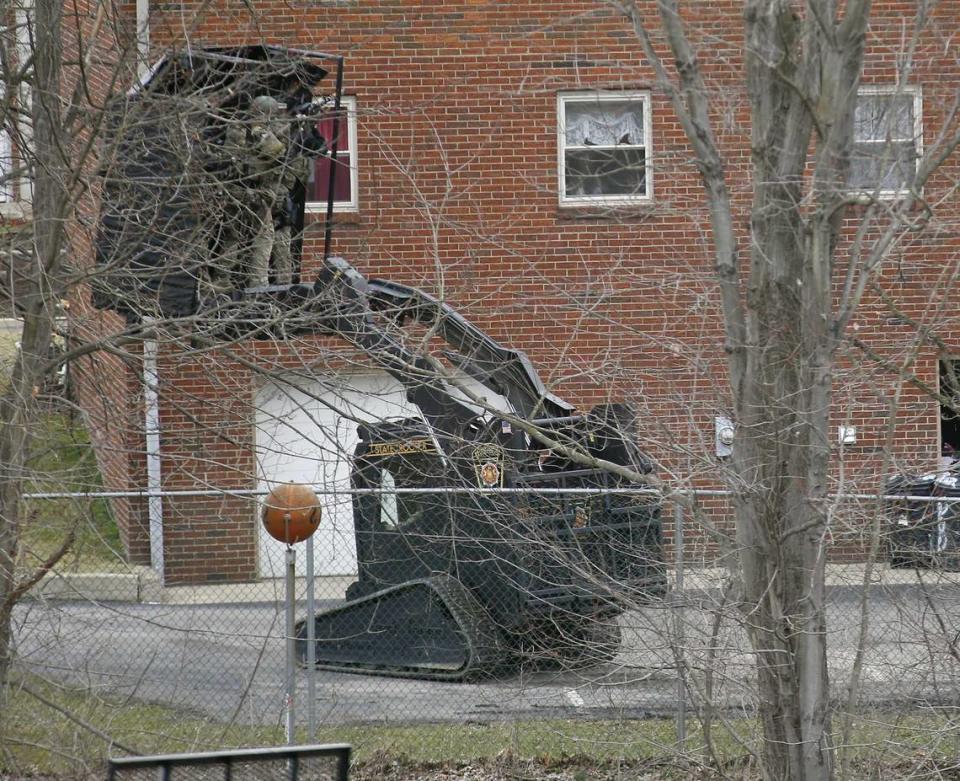‘This is not a war zone’: Sacramento City Council approves Rook police vehicle over objections
The Sacramento City Council on Tuesday approved a $430,000 purchase of an armored vehicle for the Police Department despite numerous objections that challenged elected officials to stop further militarization of police.
The City Council voted 7-2 to authorize the purchase of the armored vehicle called the Rook. Council members Katie Valenzuela and Mai Vang voted against the purchase. The item was initially listed in the City Council’s consent calendar agenda, but it was pulled to allow public comment during Tuesday’s meeting.
Discussion about obtaining the Rook lasted nearly two hours before the vote was taken. It was the first controversial issue since the November election created a liberal bloc of four members on the City Council.
Valenzuela said wanting a newer or more nimble armored vehicle, or simply wanting another one, should not be the criteria to evaluate the acquisition of this equipment. Even though the vehicle purchase is funded through a federal grant, Valenzuela said it’s still funded by the taxpayers and should not be taken lightly when there are plenty of urgent funding priorities to make sure residents are safe when emergencies arise.
“This is not a war zone. This is our community,” Valenzuela said during Tuesday’s meeting. “Further militarizing our law enforcement is moving us in the wrong direction.”
She said she is absolutely concerned about the safety of officers. But Valenzuela believes it’s possible to achieve that goal while still adhering to a state law that governs the procurement and use of military equipment by law enforcement.
Sacramento Police Chief Kathy Lester said no city funding would be used to purchase the Rook because it is federally funded by an Urban Area Security Initiative grant.
“We understand that any item that has a military appearance rightfully raises concerns and questions in our community. And we are very sensitive to that,” Lester said. “While this equipment does have armored-plating for officer protection, it is not employed in any of the traditional senses of military use.”
California Assembly Bill 481, approved in 2021, requires law enforcement agencies to seek community feedback on the acquisition, funding and use of military equipment. It is aimed at giving the public a voice in the acquisition and use of military-grade materiel that could have a negative effect on communities, according to the legislation.
Sacramento Mayor Darrell Steinberg and Council Members Lisa Kaplan, Sean Loloee, Karina Talamantes, Caity Maple, Eric Guerra and Rick Jennings voted to approve the armored vehicle purchase.
Councilwoman Maple apologizes
Maple, who was elected in November, said during her campaign that she supported the demilitarization of law enforcement. As a Sacramento activist running last year to represent Oak Park, Hollywood Park and south Sacramento neighborhoods east of Freeport Boulevard, Maple told The Sacramento Bee, “Militarizing the police force has become normal, (and) the more normal it becomes, the more equipment they add on.”
In a thread posted Wednesday afternoon on the councilwoman’s Twitter account, Maple said she voted to approve the Rook acquisition because she believes the armored vehicle “will help both the community and law enforcement stay safe.”
“I know that I could — and should — have done better outreach to the community leading up to this, and for that, I’m sorry,” Maple wrote in the Twitter thread. “I also acknowledge and understand that some residents do not agree and feel hurt by this decision — particularly in Black and Brown communities that have been historically overpoliced. It was my responsibility to do proactive outreach, and I failed.”

The councilwoman said she and her staff are planning a town hall meeting on the use of law enforcement equipment, so she can be better prepared to take action on similar issues in the future.
Residents and community activists spoke against the Rook purchase during the meeting, calling the armored vehicle an “earth-moving, wall-breaking sniper tank” that would continue to erode the public’s trust in the Police Department and further traumatize disadvantaged neighborhoods.
Jennings — who represents Land Park, the Pocket and south Sacramento west of Freeport — said he was voting for the Rook to protect the lives of residents and officers. He said he understands the concerns people have about the acquisition of this armored vehicle.
“But I also understand the value of life,” Jennings said in Tuesday’s meeting, “and the opportunity to have the equipment when you need it.”
Timothy Davis, president of the Sacramento Police Officers Association, spoke during the public comment portion and urged the council to approve the Rook purchase as defensive safety equipment needed to keep officers safe as they try to de-escalate dangerous situations.
Councilwoman Vang — who represents Meadowview and Valley-Hi/North Laguna among other south Sacramento districts — said she knows this is a world in which law enforcement is a default to public safety, “it’s all that we’ve known.” And she said the council members work closely with police captains assigned to their districts to interrupt violence in their communities.
“But if we look at studies over and over again and really listen to the community, we know that the answer to addressing the root of violence is in community care,” Vang said in the meeting. “And it’s in making sure that we invest in our community.”

Armored Critical Incident Vehicle
The Rook was purchased for $439,894 from a Florida-based company called Ring Power, which calls the Rook an Armored Critical Incident Vehicle. It’s unclear when the agency would take delivery of the vehicle.
The police chief told the council that the Rook is an armored vehicle on a track platform, which has become a standard tool for many police departments throughout the country. Lester said the Rook allows officers the mobility to gain safe positions of advantage and provides opportunities for them to resolve dangerous situations using de-escalation techniques and potentially less force “when dealing with really violent people.”
“This piece of equipment is highly specialized. It’s not used for routine operations,” Lester told the council. “And it will only be used in the most dangerous of situations.
“It’s not used for things like protests or camp cleanups.”
The Rook’s anticipated use is for serving search warrants, hostage situations, barricaded persons and other dangerous circumstances, according to a city staff report. It’s identified as a “rescue vehicle” with an armored deployment platform that can lift officers to the second story of a building and be used in rescues or evacuations.
Lester said the Rook allows officers to get into tight spaces and its tracks prevent the vehicle from getting stuck in soft ground. It’s smaller than the two armored SWAT trucks the department already has. The Police Department has a report on military equipment usage, including the two BearCat SWAT trucks it owns, posted on its website.
Kaplan — another newly elected member of the council who represents North Natomas — asked the Police Department to provide clear definitions of which incidents would trigger the use of the Rook.
“I’m putting some faith in you, we have a lot of work to do,” Kaplan told the police chief from the dais. “I will be approving this, but I will be watching because I believe there needs to be that balance of accountability and transparency.”

SWAT team tactics
Deputy Police Chief Norm Leong told the council that the department’s SWAT team has been shot at while using armored vehicles in three incidents since 2019. In those three incidents, over 100 gunshots were fired at the specially-trained officers.
Leong said the SWAT team has moved to a “much safer tactic” for suspects and officers called “surround and callout,” which replaces so-called raids that involve officers breaking into a home or building and moving quickly inside.
He said the safer surround and callout tactic requires cover for officers to see the front door and armored protection to communicate with the suspect inside over an extended period to “hopefully get the person to surrender peacefully.”
The Police Department has asked the Sheriff’s Office for assistance with its Rook 13 times since 2019, Leong said. In three of those incidents, the sheriff’s Rook did not arrive in time to be used.
As part of the approval of the purchase, the Police Department must work with Sacramento Community Police Review Commission members to define limitations on usage of the Rook and provide reports of its usage to the City Council and the residents in whichever area it’s used.
“The policymakers and the public should know within a reasonable period of time after the fact when (the Rook) is used,” Steinberg said. “That’s it. It’s transparency.”

What can the Rook do?
A description of the Rook in the city staff report says the vehicle has a “grapple claw” used to remove fortified doors, burglar bars or exterior shrubbery. It also has a vehicle extraction tool to move or immobilize a vehicle or remove obstructions.
Funds for the Rook are coming from a Homeland Security grant from the Federal Emergency Management Agency and provides “funding to enhance regional preparedness and capabilities in designated high-threat, high-density areas.” The Homeland Security grant program is intended to assist state and local agencies “in preventing, protecting against, mitigating, responding to and recovering from acts of terrorism and other threats.”
Before Tuesday’s vote, City Manager Howard Chan warned council members that failing to approve this purchase would cause the Police Department to lose the grant award for the Rook purchase. The money would go back to FEMA, where a decision would be made on how to best use that funding elsewhere in the Sacramento region.
Chan also said choosing not to approve the Rook purchase would give the Police Department fewer “tools” to use and make the city “less safe.”
“This council has been committed to investing time, effort and resources in less-than-lethal options as we have these interactions with the public,” said City Manager Howard Chan. “And this is yet another tool in that toolbox.”

 Yahoo Movies
Yahoo Movies 
